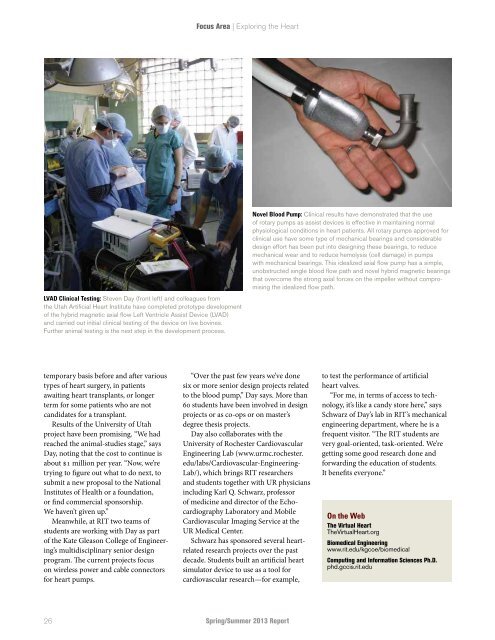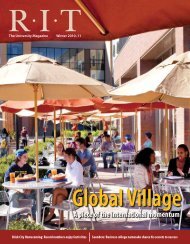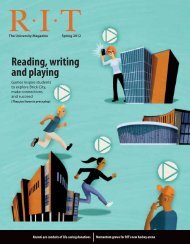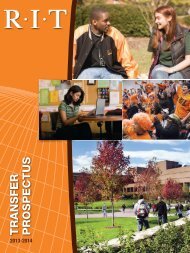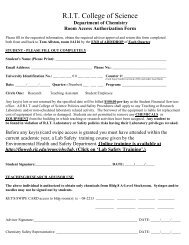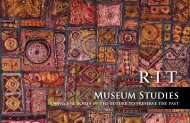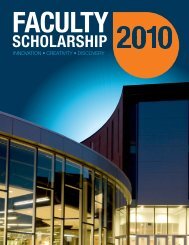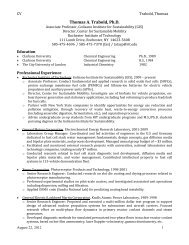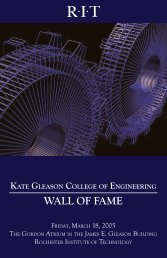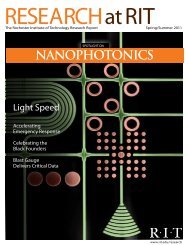Spring / Summer 2013 - Rochester Institute of Technology
Spring / Summer 2013 - Rochester Institute of Technology
Spring / Summer 2013 - Rochester Institute of Technology
Create successful ePaper yourself
Turn your PDF publications into a flip-book with our unique Google optimized e-Paper software.
Focus Area | Exploring the Heart<br />
LVAD Clinical Testing: Steven Day (front left) and colleagues from<br />
the Utah Artificial Heart <strong>Institute</strong> have completed prototype development<br />
<strong>of</strong> the hybrid magnetic axial flow Left Ventricle Assist Device (LVAD)<br />
and carried out initial clinical testing <strong>of</strong> the device on live bovines.<br />
Further animal testing is the next step in the development process.<br />
Novel Blood Pump: Clinical results have demonstrated that the use<br />
<strong>of</strong> rotary pumps as assist devices is effective in maintaining normal<br />
physiological conditions in heart patients. All rotary pumps approved for<br />
clinical use have some type <strong>of</strong> mechanical bearings and considerable<br />
design effort has been put into designing these bearings, to reduce<br />
mechanical wear and to reduce hemolysis (cell damage) in pumps<br />
with mechanical bearings. This idealized axial flow pump has a simple,<br />
unobstructed single blood flow path and novel hybrid magnetic bearings<br />
that overcome the strong axial forces on the impeller without compromising<br />
the idealized flow path.<br />
temporary basis before and after various<br />
types <strong>of</strong> heart surgery, in patients<br />
awaiting heart transplants, or longer<br />
term for some patients who are not<br />
candidates for a transplant.<br />
Results <strong>of</strong> the University <strong>of</strong> Utah<br />
project have been promising. “We had<br />
reached the animal-studies stage,” says<br />
Day, noting that the cost to continue is<br />
about $1 million per year. “Now, we’re<br />
trying to figure out what to do next, to<br />
submit a new proposal to the National<br />
<strong>Institute</strong>s <strong>of</strong> Health or a foundation,<br />
or find commercial sponsorship.<br />
We haven’t given up.”<br />
Meanwhile, at RIT two teams <strong>of</strong><br />
students are working with Day as part<br />
<strong>of</strong> the Kate Gleason College <strong>of</strong> Engineering’s<br />
multidisciplinary senior design<br />
program. The current projects focus<br />
on wireless power and cable connectors<br />
for heart pumps.<br />
“Over the past few years we’ve done<br />
six or more senior design projects related<br />
to the blood pump,” Day says. More than<br />
60 students have been involved in design<br />
projects or as co-ops or on master’s<br />
degree thesis projects.<br />
Day also collaborates with the<br />
University <strong>of</strong> <strong>Rochester</strong> Cardiovascular<br />
Engineering Lab (www.urmc.rochester.<br />
edu/labs/Cardiovascular-Engineering-<br />
Lab/), which brings RIT researchers<br />
and students together with UR physicians<br />
including Karl Q. Schwarz, pr<strong>of</strong>essor<br />
<strong>of</strong> medicine and director <strong>of</strong> the Echocardiography<br />
Laboratory and Mobile<br />
Cardiovascular Imaging Service at the<br />
UR Medical Center.<br />
Schwarz has sponsored several heartrelated<br />
research projects over the past<br />
decade. Students built an artificial heart<br />
simulator device to use as a tool for<br />
cardiovascular research—for example,<br />
to test the performance <strong>of</strong> artificial<br />
heart valves.<br />
“For me, in terms <strong>of</strong> access to technology,<br />
it’s like a candy store here,” says<br />
Schwarz <strong>of</strong> Day’s lab in RIT’s mechanical<br />
engineering department, where he is a<br />
frequent visitor. “The RIT students are<br />
very goal-oriented, task-oriented. We’re<br />
getting some good research done and<br />
forwarding the education <strong>of</strong> students.<br />
It benefits everyone.”<br />
On the Web<br />
The Virtual Heart<br />
TheVirtualHeart.org<br />
Biomedical Engineering<br />
www.rit.edu/kgcoe/biomedical<br />
Computing and Information Sciences Ph.D.<br />
phd.gccis.rit.edu<br />
26<br />
<strong>Spring</strong>/<strong>Summer</strong> <strong>2013</strong> Report


